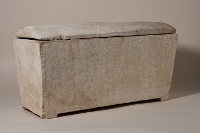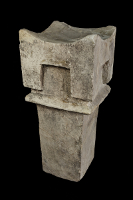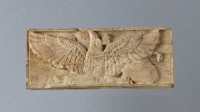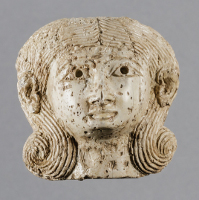Highlights from the Collection: Palestine
The name Palestine, derived from the names of the ancient Philistines, refers to the geographical area that comprises most of what is now Israel and Jordan. The Oriental Institute Museum houses a spectacular collection of Palestinian materials from pre- World War II Institute excavations at the site of Megiddo. This large mound, on the west side of the fertile and relatively broad plain of Esdraelon, contains the remains of Canaanite Megiddo (often associated with the Biblical Armageddon). It yielded an almost complete sequence of levels from the fifth millennium B.C. to at least the 4th century B.C. The museum's most famous objects from the site are its share of the Megiddo ivories, dating to the 13th century B.C., but the collection also includes an extraordinarily full range of artifacts documenting the rise and development of the city and its culture. Later Oriental Institute excavations in the 1960's at Beth Yerah (Khirbet Kerak) on the southwest shore of the Sea of Galilee and at Nahal Tabor in the Jordan Valley added Early Bronze Age materials not well represented by the Megiddo collection.
Fragment of a Scroll
This fragment from a Hebrew manuscript was once part of a library of scrolls hidden in caves near the Dead Sea. The parchment texts, wrapped in linen and stored in pottery jars, were hidden in the first century A.D. and recovered between 1947 and 1956, at which time they became known as the Dead Sea Scrolls. The biblical writings on many of these scrolls are the earliest known Hebrew copies of Old Testament texts. The text on this fragment comes from a non- biblical Essene psalter, similar to the Psalms of the Bible.
Kernos Ring
This ring was probably used as a libation vessel during religious ceremonies in ancient Palestine. It consists of a hollow clay ring with hollow clay attachments in the forms of a gazelle head, two jars, two pomegranates, two doves, and a cup. The doves, whose heads have been restored, drink from the cup. An eighth attachment is missing, having been broken off in antiquity.
The pomegranate, the gazelle and the doves suggest that this ring was associated with a fertility cult. Wine or water would have been poured into the cup and circulated through the other objects attached to the ring, thus symbolizing the fertility of the earth and its produce.
Kernos rings are fairly common in Palestine, although few are as elaborate or as well preserved as this one.
Canaanite Statuette
 This statuette of a god may have been the cult figure in the Canaanite temple in the ruins of which it was found. Cast in bronze and covered with gold leaf, it is an idol of the type forbidden by the much later Hebrew prophets. The identity of this bearded and enthroned deity is uncertain but is most likely to be El-the chief god of the pantheon and father of the other gods.
This statuette of a god may have been the cult figure in the Canaanite temple in the ruins of which it was found. Cast in bronze and covered with gold leaf, it is an idol of the type forbidden by the much later Hebrew prophets. The identity of this bearded and enthroned deity is uncertain but is most likely to be El-the chief god of the pantheon and father of the other gods.
Inscribed Ossuary
The name "Yo-ezer the scribe" is inscribed on one end of this ossuary, a repository for bones. Around the end of the 1st century B.C., Jewish burial practices changed from primary burial in wooden coffins to secondary burial in small limestone caskets such as this one. The body seems first to have been buried in a pit until only the bones remained. These were then gathered up and transferred to the ossuary, which was placed in a rock-hewn communal tomb.
This ossuary is decorated with incised geometric designs. The Hebrew inscription on the side reads "Yo-ezer, son of Yehohanan, the scribe."
Four-Horned Incense Altar
Horned altars are described in the Bible and have been discovered at many Iron Age Israelite sites. This example is probably too small to have been used for animal sacrifice, but may have served for the other three types of offerings known to have been made: wine, incense, and grain meal mixed with oil. The Megiddo stratum in which this altar was found was characterized by large public structures and is generally thought to have been built by King Solomon. It included a four-entryway gate and a well-built double or "casemate" wall.
Gaming Board
Two types of gaming boards are found among the Megiddo ivories- one for the "game of 58 holes" and the other for the "game of 20 squares." This is one of four similarly-shaped gaming boards for the "game of 58 holes." Every fifth hole, as well as the central panel, was once inlaid with gold and blue paste. "Studs" of gold leaf found alongside the board may have capped the pegs used to play the game.
Griffin Plaque
This plaque is one of a group of ivories discovered at Megiddo in a semi-subterranean chamber that archaeologists called the "treasury," within a large building that may have been a palace. It bears the figure of a reclining griffin-a composite creature with a lion's body and a bird's head and wings. This motif is borrowed from the art of the Mycenaeans, but it is uncertain whether the object itself was made by a Mycenaean craftsman settled in Asia, by a local ivory carver imitating Mycenaean prototypes, or was imported directly from Greece.
Oil Lamp
Lamps such as this one consist of a bowl to hold fuel, which was usually olive oil, and a spout to support a wick, which was probably made of flax. The burning wick blackened the spout and must have produced a rather smoky light. The shape of these lamps changed over time, going from an open bowl with four pinched spouts to the one-spouted type shown here and, finally, to a closed lamp with a single spout. These differences in shape are one type of evidence used by archaeologists to date the levels they are excavating.
Three Female Heads
These delicate heads belong to a group of ivories discovered at the site of Megiddo, in Palestine. They had been stored in a semi- subterranean chamber that archaeologists called "the treasury," within a large building that may have been a palace. Pairs of heads such as these were attached to cosmetic boxes. A dowel inserted behind one head functioned as the hinge for a flat lid; a dowel behind the other served to fasten the lid closed. The heads show traces of Egyptian influence in their heavily curling locks of hair, which are characteristic of the Egyptian goddess Hathor.









